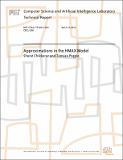| dc.contributor.advisor | Tomaso Poggio | |
| dc.contributor.author | Chikkerur, Sharat | en_US |
| dc.contributor.author | Poggio, Tomaso | en_US |
| dc.contributor.other | Center for Biological and Computational Learning (CBCL) | en_US |
| dc.date.accessioned | 2011-04-21T18:15:06Z | |
| dc.date.available | 2011-04-21T18:15:06Z | |
| dc.date.issued | 2011-04-14 | |
| dc.identifier.uri | http://hdl.handle.net/1721.1/62293 | |
| dc.description.abstract | The HMAX model is a biologically motivated architecture for computer vision whose components are in close agreement with existing physiological evidence. The model is capable of achieving close to human level performance on several rapid object recognition tasks. However, the model is computationally bound and has limited engineering applications in its current form. In this report, we present several approximations in order to increase the efficiency of the HMAX model. We outline approximations at several levels of the hierarchy and empirically evaluate the trade-offs between efficiency and accuracy. We also explore ways to quantify the representation capacity of the model. | en_US |
| dc.format.extent | 12 p. | en_US |
| dc.relation.ispartofseries | MIT-CSAIL-TR-2011-021 | |
| dc.relation.ispartofseries | CBCL-298 | |
| dc.rights | Creative Commons Attribution-NonCommercial-NoDerivs 3.0 Unported | en |
| dc.rights.uri | http://creativecommons.org/licenses/by-nc-nd/3.0/ | |
| dc.subject | object recognition, approximation | en_US |
| dc.title | Approximations in the HMAX Model | en_US |
